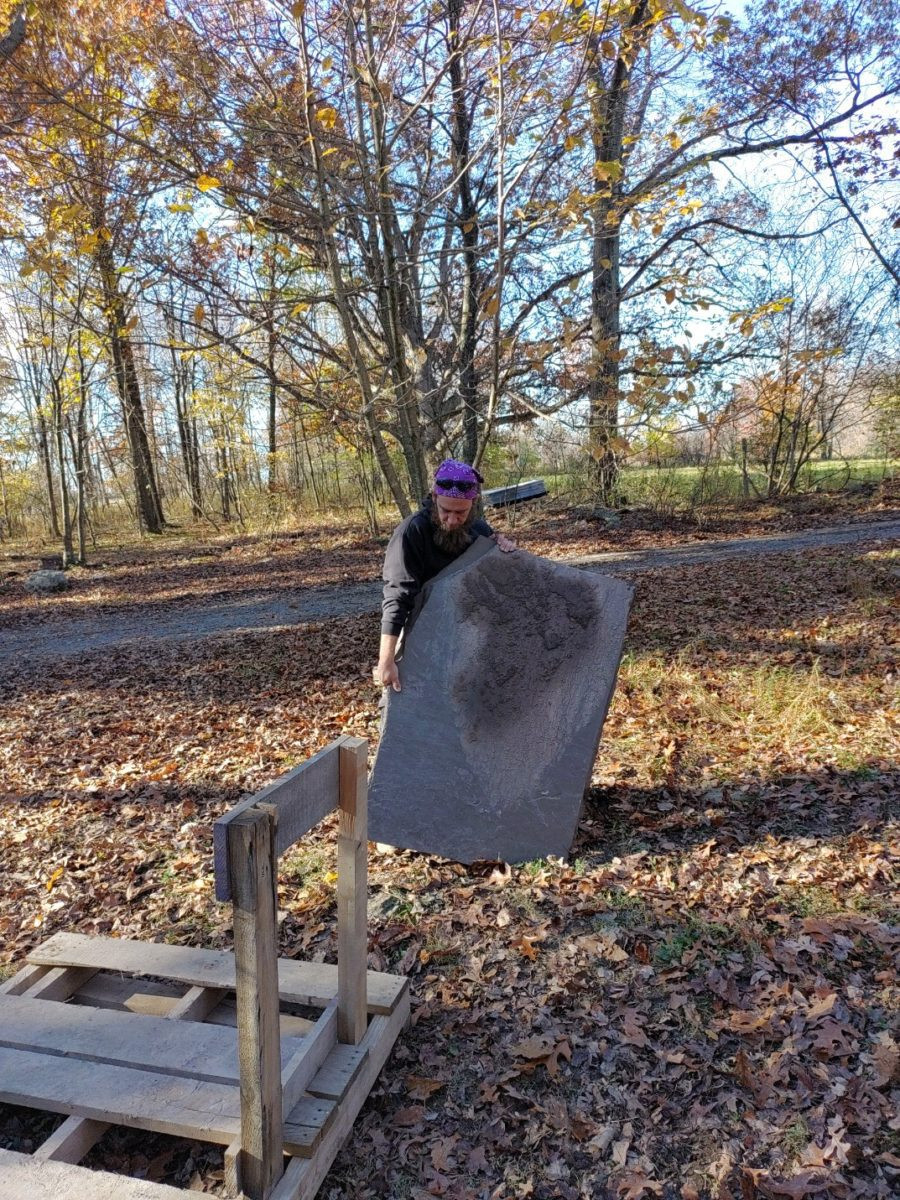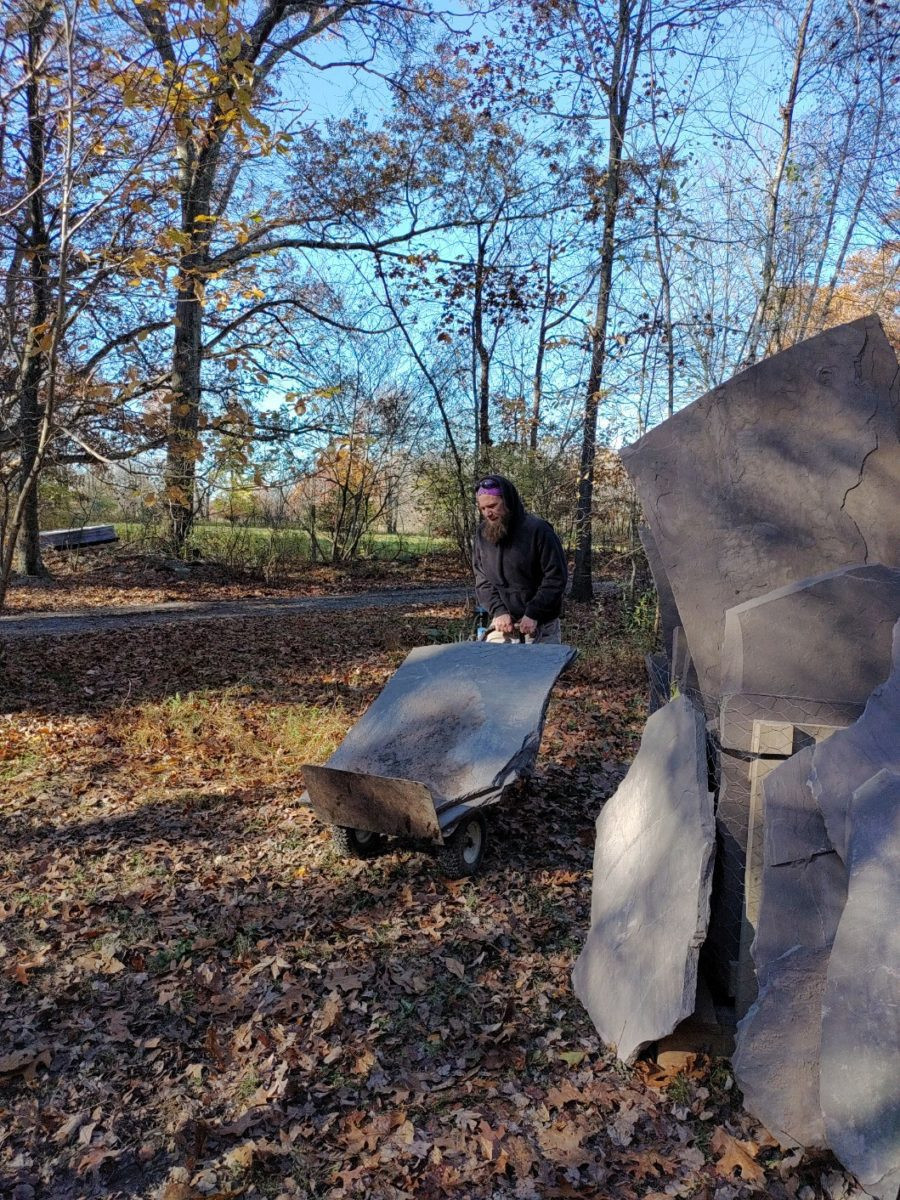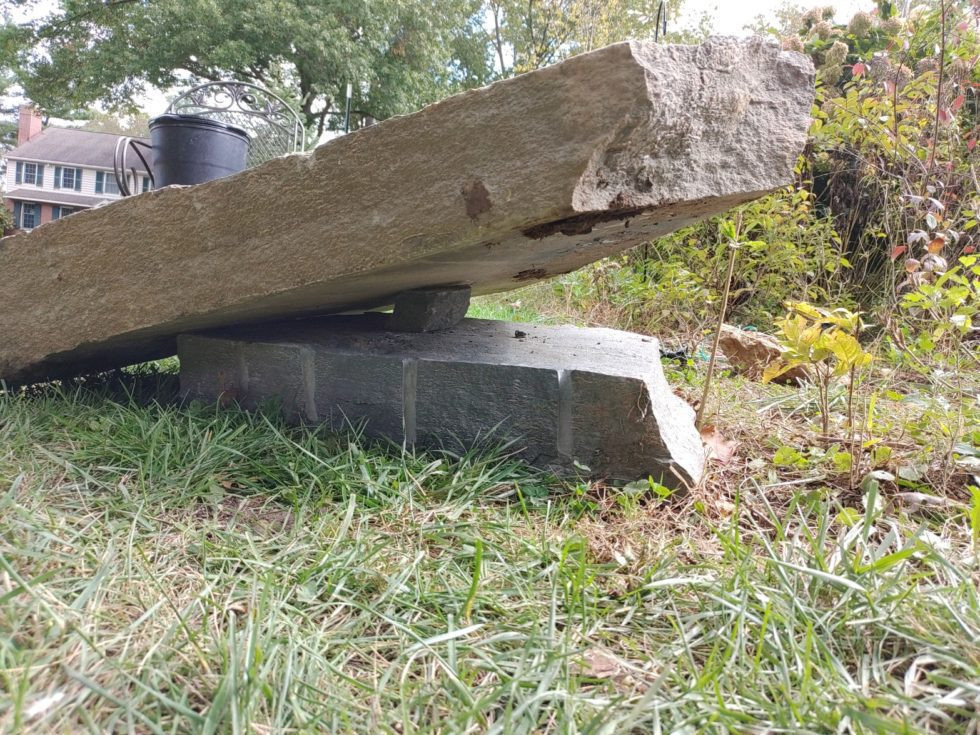Are you looking for ways on How To Lift Large Rocks for your landscaping project? Rockscapes.net provides simple methods to lift and maneuver heavy rocks without heavy machinery! Ready to transform your outdoor space? Let’s explore how to lift large rocks with these expert tips, safety precautions, and innovative techniques.
1. Understanding the Basics of Lifting Large Rocks
Before diving into the specifics of how to lift large rocks, it’s important to understand the fundamental principles and preparations involved. This section will cover essential aspects such as assessing the stone, gathering necessary tools, and prioritizing safety.
1.1. Assessing the Stone
Before attempting to move a large rock, take a moment to evaluate its size, weight, and shape. Understanding these characteristics will help you determine the best approach and the necessary equipment.
- Size: Estimate the dimensions of the rock to get an idea of its volume.
- Weight: Try to estimate the weight of the rock. If possible, consult a professional or use online calculators that estimate weight based on dimensions and material type.
- Shape: Note the shape of the rock, as this will influence how you can grip, lift, and maneuver it. Irregularly shaped rocks may require specialized techniques or equipment.
1.2. Gathering the Right Tools
Having the right tools can make the job of lifting large rocks significantly easier and safer. Here are some essential tools to consider:
- Pry Bar or Mattock: A sturdy pry bar or mattock can be used to lift and maneuver rocks by providing leverage. Look for one with a comfortable grip and a durable construction.
- Rock Dolly: A rock dolly is a wheeled platform designed for moving heavy objects. Choose a dolly with a high weight capacity and sturdy wheels that can handle rough terrain.
- Rollers or Pipes: Steel pipes or rollers can be placed under the rock to help it roll along the ground. This method reduces friction and makes it easier to move the rock over longer distances.
- Gloves: Wear heavy-duty gloves to protect your hands from sharp edges and abrasions.
- Safety Glasses: Protect your eyes from flying debris by wearing safety glasses.
- Steel-Toed Boots: Steel-toed boots can prevent foot injuries if a rock accidentally falls.
1.3. Prioritizing Safety
Lifting large rocks can be dangerous if proper safety precautions are not followed. Here are some important safety tips to keep in mind:
- Assess the Area: Clear the area of any obstacles or hazards that could cause you to trip or lose your balance.
- Use Proper Lifting Techniques: Lift with your legs, not your back, and keep the rock close to your body.
- Get Help When Needed: Don’t hesitate to ask for assistance if the rock is too heavy or awkward to move on your own.
- Wear Appropriate Gear: Always wear gloves, safety glasses, and steel-toed boots to protect yourself from injuries.
- Stay Hydrated: Drink plenty of water to stay hydrated, especially when working in hot weather.
- Take Breaks: Take frequent breaks to avoid fatigue, which can increase the risk of accidents.
By understanding the basics of assessing the stone, gathering the right tools, and prioritizing safety, you’ll be well-prepared to tackle the challenge of lifting large rocks.
2. Ancient Techniques for Moving Minerals
These techniques for moving heavy stones are ancient. Most of them are. Yet we’re still learning and adapting, day by day. We might split a boulder in half using the ancient feather and wedge method. Next, we might move that big split boulder using the ancient pipe conveyor method. According to research from Arizona State University’s School of Earth and Space Exploration, in July 2025, ancient methods remain effective for moving large stones due to their simplicity and reliance on fundamental physics.
2.1. Walking Large Stones
Walking large slabs upright and walk it–corner to corner. With the wheel method, you stand up the slab and roll it–as if it were circular shaped. Often, we’ll end up walking a large slab of stone maybe 10′ or so, and then we may need to wheel it for the last few feet, to get over and around an obstacle, or something.
 Moving heavy rocks without machinery
Moving heavy rocks without machinery
Walking heavy flagstone without machinery is an effective way to move large slabs over short distances.
The wheel method isn’t getting its own listing here. It is considered just a variation on the walking method, which is itself used much more often. Just stand the slab up and then pretend you are trying to invent the wheel, using an unlikely shape.
2.2. The Dolly
It’s worthwhile to buy the largest and sturdiest dolly you can find. We’ve moved some heavy boulders, with that dolly.
 Moving heavy stones using a dolly
Moving heavy stones using a dolly
Moving flagstone with a dolly is a practical and efficient method for transporting heavy stones.
2.3. Create a Pivot Point
Pry up that stone. When you pry, take the blade end of your mattock and jam it under that stone. Secondly turn that mattock on its side. Usually you don’t want to pull the mattock back, for it may break, but turn it to its side/lay it down. Now that stone is up, a little bit you can slide a rock under there right at the edge of that stone and pull the mattock (or other pry tool) out. Next, now that the stone is up a bit, you can slide a different rock into the middle of that big stone. After that, you can pry up again with the mattock–and pull out that first rock from the stone’s edge. Now, your heavy stone is situated with a pivot point at the center.
 Pivot point for moving large stones
Pivot point for moving large stones
Creating a pivot point is essential for effectively moving large stones, providing leverage and stability.
So we’ve created a lever. A see-saw. From here, you can easily spin a very heavy stone, and turn it 180 degrees if you want to. Or, you can see-saw one side up higher, and place a larger pivot stone under there–now, you can see-saw it even higher.
To make spinning the heavy stone easier, I usually keep a stone ball or two on hand. A 2″ chunk of gravel will do the trick, but a 1 or 2″ ball of stone placed underneath a big heavy stone will make spinning it around much smoother.
2.4. Moving Heavy Stones Using Rollers
Pry up the stone and slide a steel pipe underneath it. Then another, and a third. Now you can roll that bad boy. Either push the thing, or take a rope, tow strap or what-have-you and pull it. So in this photo we used only two rollers.
3. Techniques for Lifting and Flipping Heavy Stones
Often a worker will point to a heavy stone and say something to me like “hey, can you give me a hand”. Well, if the stone is so heavy that the two of us will both be struggling–then it is safer for me to just lift it alone. Two guys may not communicate perfectly. Or, what if your partner slips? Here’s how it’s done:
3.1. Lifting a Heavy Stone Off the Ground
Stand that stone up right, then roll it up on top of another stone. Now, you’re already off the ground, a bit. Stand that stone upright again… Now lean that stone over your thigh… Balance it across your leg and look at you now–that heavy stone is completely off the ground! Once I’ve got a stone balanced across my thigh like that, the next step is usually to get my hands under it and heft the thing up to my waist in one movement. Next it’s up into the bed of a truck, or unto a wall, in another movement.
3.2. Flipping Over a Stone That Is Too Heavy to Lift
First, pry that stone off the ground an inch or so, using a pick axe or pick mattock, and slide a small stone under there while it’s an inch or so up. Now, you have a start and now it will be easier to get a pry tool in there and get it up higher. I might reach for the mattock again, or if the piece is heavier maybe we’ll go with the digging bar. Pry the stone up like 4 or 7 inches high now–and slide a bigger rock under there. Now, that heavy stone is already halfway stood up. At this stage I’ll put the tool down and just lift that stone all the way into a standing up position. Now that it’s standing up, we can get it on to a dolly and wheel the thing across the jobsite.
Or, we can lay out a chain on the ground and flop the stone on top of that chain. Now, we can wrap it up in that chain and lift it off the ground using a gantry crane.
4. Advanced Equipment: Gantry Cranes and Hoists
4.1. Investing in a Gantry Crane, Crane Trolley, and Chain Hoist
I had this idea for a decade before actually enacting it. Can’t say I regret waiting though because the ten years of not having that crane gave me plenty of opportunities to develop the other techniques described above.
 Moving heavy stones with gantry crane
Moving heavy stones with gantry crane
Moving heavy stones with a gantry crane ensures precision and safety in garden landscaping projects.
5. Safety Precautions and Important Considerations
Here are some notes on safety precautions. If you have to grunt, you’re probably doing it wrong. Always stretch and hydrate. Take care of yourself, physically first. Don’t twist your back, while carrying a heavy weight and don’t use your back, use your head! Knees, arms, back, the whole body can take strain, doing this sort of work. It can barely be avoided–this is hard work. But you can always think, and usually you can come up with an easier way to move a stone.
For example, you might say okay, this heavy stone needs to be moved, well I can just heft it up and toss it over there! But then again, is there an easier way, a way that will strain my body a bit less? if so, go with the less straining way! Look, I sell almost 100% of my jobs as flat-rate. The customer pays for the whole job, not by the hour or by the day. That means there’s motivation for me to get it done. But then again, in the long run–it’s much better for me if my employees and myself are in good shape. That 30 seconds that you might save by doing it a faster way will cost you hours later, when you’re aching and dragging.
5.1. Body Mechanics and Injury Prevention
Maintaining proper body mechanics is crucial when lifting and moving heavy stones to prevent injuries. Here are some key points to keep in mind:
- Use Your Legs: When lifting, bend at your knees and keep your back straight. Let your leg muscles do the work, rather than straining your back.
- Keep the Load Close: Hold the stone as close to your body as possible to reduce the amount of stress on your back.
- Avoid Twisting: When turning, move your feet rather than twisting your torso. Twisting can put excessive strain on your spine.
- Take Small Steps: When carrying a heavy stone, take small, deliberate steps to maintain your balance.
- Communicate with Partners: If working with others, communicate clearly and coordinate your movements to avoid collisions or dropped stones.
5.2. Environmental Considerations
When working with stones, it’s important to be mindful of the environment and take steps to minimize your impact. Consider these factors:
- Source Stones Responsibly: Whenever possible, source stones from local suppliers or quarries that follow sustainable practices.
- Minimize Disturbance: Avoid disturbing natural habitats or ecosystems when collecting or moving stones.
- Prevent Erosion: Take measures to prevent soil erosion when creating stone features. This may involve using geotextiles, retaining walls, or vegetation to stabilize the soil.
- Dispose of Waste Properly: Dispose of any waste materials, such as broken stones or packaging, in a responsible manner.
- Respect Wildlife: Be aware of the presence of wildlife and avoid disturbing their habitats.
5.3. Weather Conditions
Weather conditions can significantly impact the safety and efficiency of moving large stones. Here’s how to adapt to different weather scenarios:
- Hot Weather: Stay hydrated by drinking plenty of water and take frequent breaks in the shade. Wear lightweight, breathable clothing and apply sunscreen to protect your skin from the sun.
- Cold Weather: Dress in layers to stay warm and dry. Wear gloves to protect your hands from the cold and provide a better grip on the stones. Be extra cautious when working on icy or slippery surfaces.
- Rainy Weather: Avoid working in heavy rain, as surfaces can become slippery and visibility may be reduced. If you must work in the rain, wear waterproof clothing and footwear and take extra care to avoid slips and falls.
- Windy Weather: Be aware of the potential for stones to be blown over by strong winds. Secure stones that are not yet in place and avoid working in exposed areas where the wind is strong.
By considering these safety precautions and adapting to environmental and weather conditions, you can minimize the risk of accidents and ensure a successful stone-moving operation.
6. Choosing the Right Stone for Your Project
Selecting the right type of stone is essential for achieving the desired aesthetic and functional outcome in your landscaping project. Here’s an overview of popular stone types and their applications:
| Stone Type | Description | Common Uses |
|---|---|---|
| Granite | A hard, durable igneous rock with a coarse-grained texture. Available in a variety of colors. | Countertops, paving, retaining walls, decorative accents. |
| Limestone | A sedimentary rock composed primarily of calcium carbonate. Softer and more porous than granite. | Paving, wall cladding, garden borders, decorative features. |
| Slate | A fine-grained metamorphic rock that splits easily into thin layers. Known for its durability and water resistance. | Roofing, paving, wall cladding, garden pathways. |
| Sandstone | A sedimentary rock composed of sand-sized grains of minerals, rock, or organic material. Available in a range of colors and textures. | Paving, wall cladding, garden steps, decorative accents. |
| Fieldstone | Naturally occurring stones found on the surface of the earth. Typically rounded or irregular in shape. | Retaining walls, garden borders, decorative features, dry-stacked walls. |
| River Rock | Smooth, rounded stones found in riverbeds. Available in various sizes and colors. | Garden pathways, drainage systems, decorative ground cover, water features. |
| Flagstone | Flat, thin slabs of sedimentary rock used for paving and walkways. | Patios, walkways, garden paths, stepping stones. |
| Arizona Flagstone | Flagstone quarried in Arizona, known for its warm colors and durability. | Patios, walkways, garden paths, stepping stones in arid climates. |
6.1. Considerations for Stone Selection
In addition to the type of stone, consider the following factors when selecting stones for your project:
- Color: Choose stones that complement the color scheme of your landscape and architecture.
- Texture: Consider the texture of the stone and how it will feel underfoot or to the touch.
- Size and Shape: Select stones that are appropriately sized and shaped for their intended use.
- Availability: Check the availability of the stone in your area and factor in transportation costs.
- Cost: Compare the costs of different types of stone and choose one that fits your budget.
6.2. Sourcing Quality Stones
When sourcing stones for your project, it’s important to choose a reputable supplier who can provide high-quality materials. Here are some tips for finding a reliable stone supplier:
- Check Reviews: Read online reviews and testimonials to get an idea of the supplier’s reputation.
- Visit the Yard: Visit the supplier’s yard to inspect the stones firsthand and assess their quality.
- Ask Questions: Ask the supplier about the origin of the stones, their durability, and any special care requirements.
- Compare Prices: Compare prices from different suppliers to ensure you’re getting a fair deal.
- Check for Certifications: Look for suppliers who are certified by industry organizations or who follow sustainable practices.
By carefully considering these factors and selecting the right type of stone from a reputable supplier, you can create a stunning and long-lasting landscape feature that will enhance the beauty of your outdoor space.
7. Landscaping Applications
7.1. Rock Gardens
Rock gardens are a beautiful way to display various types of stones. Select stones in various sizes, shapes, and colors to create visual interest. Place the largest stones first, then fill in with smaller stones. Add plants that thrive in rocky environments, such as succulents, alpine plants, and drought-resistant shrubs.
7.2. Water Features
Stones are often used to create natural-looking waterfalls, ponds, and streams. Use large stones to define the edges of the water feature and create cascades. Place smaller stones in the water to provide habitat for aquatic life. Select stones that are smooth and rounded to avoid sharp edges.
7.3. Pathways and Walkways
Stones can be used to create attractive and durable pathways and walkways. Use flagstones or stepping stones to create a formal pathway. Use gravel or crushed stone to create a more informal pathway. Make sure the stones are level and stable to avoid tripping hazards.
7.4. Retaining Walls
Retaining walls are used to hold back soil and create level areas in sloped landscapes. Use large stones to create a strong and stable retaining wall. Make sure the wall is properly engineered to withstand the pressure of the soil. Add drainage to prevent water from building up behind the wall.
7.5. Decorative Accents
Stones can be used as decorative accents in a variety of ways. Use large boulders as focal points in the landscape. Use smaller stones to create borders around flower beds or trees. Use pebbles or gravel to create patterns or designs.
8. Ideas and Inspiration for Landscape Design
To gather ideas and inspiration for landscape design, consider these resources:
- Magazines: Magazines like “Better Homes and Gardens,” “Landscapes,” and “Sunset” often feature articles and photos of beautiful landscapes.
- Books: Books on landscape design can provide detailed information on design principles, plant selection, and construction techniques.
- Websites: Websites like rockscapes.net offer a wealth of information on landscape design, including photos, articles, and videos.
- Gardens: Visit local gardens and parks to see examples of different landscape styles and techniques.
- Landscape Designers: Consult with a professional landscape designer to get personalized advice and create a custom design for your property.
Address: 1151 S Forest Ave, Tempe, AZ 85281, United States.
Phone: +1 (480) 965-9011.
Website: rockscapes.net.
9. Maintaining Your Stone Features
9.1. Cleaning and Sealing
Regular cleaning and sealing can help to protect your stone features from dirt, stains, and weathering. Here are some tips for cleaning and sealing your stones:
- Clean Regularly: Sweep or hose off your stone features regularly to remove dirt and debris.
- Use Mild Soap: Use a mild soap and water solution to clean stubborn stains.
- Avoid Harsh Chemicals: Avoid using harsh chemicals or abrasive cleaners, as they can damage the stone.
- Seal Periodically: Seal your stone features periodically to protect them from moisture and stains.
- Choose the Right Sealer: Choose a sealer that is specifically designed for the type of stone you have.
9.2. Repairing Damage
Over time, your stone features may become damaged due to weathering, impact, or other factors. Here are some tips for repairing damage to your stones:
- Fill Cracks: Fill cracks with a stone repair compound or epoxy.
- Replace Broken Stones: Replace broken stones with new ones that match the existing stones.
- Re-Mortar Joints: Re-mortar joints between stones to keep them stable and prevent water damage.
- Consult a Professional: Consult a professional stone mason for major repairs or restoration projects.
9.3. Preventing Weed Growth
Weeds can be a nuisance in stone features, as they can detract from the beauty of the stones and cause damage over time. Here are some tips for preventing weed growth in your stone features:
- Apply a Pre-Emergent Herbicide: Apply a pre-emergent herbicide in the spring to prevent weed seeds from germinating.
- Pull Weeds Regularly: Pull weeds regularly by hand to prevent them from spreading.
- Use a Weed Torch: Use a weed torch to burn off weeds in cracks and crevices.
- Apply Vinegar: Apply vinegar to kill weeds in cracks and crevices.
- Use Landscape Fabric: Use landscape fabric under gravel or mulch to prevent weed growth.
10. Frequently Asked Questions (FAQs)
10.1. What is the best way to lift a large rock without machinery?
Leverage, rollers, and dollies are best to lift large rock without machinery. Using a pry bar to lift the rock slightly and then placing rollers or pipes underneath allows for easier movement. A sturdy dolly can also be used to transport the rock.
10.2. What safety precautions should I take when moving heavy stones?
Wear safety glasses, gloves, and steel-toed boots. Always lift with your legs, not your back, and keep the stone close to your body. Clear the area of obstacles and get help if the rock is too heavy.
10.3. What tools are essential for lifting large rocks?
A pry bar or mattock, rock dolly, steel pipes or rollers, heavy-duty gloves, safety glasses, and steel-toed boots are essential tools. These tools provide leverage, protection, and stability.
10.4. How can I estimate the weight of a large rock?
Estimate the dimensions of the rock and consult a professional or use online calculators. These calculators estimate weight based on dimensions and material type.
10.5. What is the pivot point method for moving stones?
Creating a pivot point involves using a pry bar to lift one edge of the stone and placing a smaller rock underneath to create a lever. This allows you to spin or adjust the position of the stone more easily.
10.6. How do rollers help in moving heavy stones?
Rollers reduce friction between the stone and the ground, making it easier to push or pull the stone over longer distances. Steel pipes are commonly used as rollers.
10.7. Is it safer for one person to lift a heavy stone alone?
If the stone is so heavy that two people would struggle, it can be safer for one person to lift it using proper techniques. Two people may not communicate perfectly, increasing the risk of accidents.
10.8. What type of clothing should I wear when moving heavy stones?
Wear lightweight, breathable clothing in hot weather and dress in layers to stay warm in cold weather. Always wear gloves and sturdy footwear.
10.9. How do I prevent soil erosion when creating stone features?
Use geotextiles, retaining walls, or vegetation to stabilize the soil. These measures help prevent soil erosion and maintain the integrity of the landscape.
10.10. Where can I find quality stones for my landscaping project in the USA?
Visit rockscapes.net to explore a wide range of high-quality stones and get expert advice on selecting the right materials for your landscaping needs.
Transform your landscape with the timeless beauty of natural stone. Whether you’re envisioning a serene rock garden, a captivating water feature, or a sturdy retaining wall, rockscapes.net offers the inspiration, information, and resources you need to bring your vision to life. Explore our website today and discover the endless possibilities of stone landscaping!
